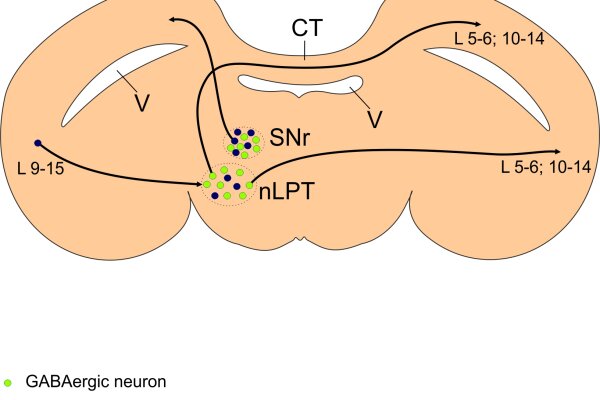2016-03-22

Previous studies have demonstrated that the optic tecta of the left and right brain halves reciprocally inhibit each other in birds. In mammals, the superior colliculus receives inhibitory γ-aminobutyric acid (GABA)ergic input from the basal ganglia via both the ipsilateral and the contralateral substantia nigra pars reticulata (SNr). This contralateral SNr projection is important in intertectal inhibition. Because the basal ganglia are evolutionarily conserved, the tectal projections of the SNr may show a similar pattern in birds. Therefore, the SNr could be a relay station in an indirect tecto–tectal pathway constituting the neuronal substrate for the tecto–tectal inhibition. To test this hypothesis, neuroscientists from the Biopsychology performed bilateral anterograde and retrograde tectal tracing combined with GABA immunohistochemistry in pigeons. Suprisingly, they found out that the SNr has only ipsilateral projections to the optic tectum, and these are non-GABAergic. Inhibitory GABAergic input to the contralateral optic tectum arises instead from a nearby tegmental region that receives input from the ipsilateral optic tectum. Thus, a disynaptic pathway exists that possibly constitutes the anatomical substrate for the inhibitory tecto–tectal interaction. This pathway likely plays an important role in attentional switches between the laterally placed eyes of birds.

Previous studies have demonstrated that the optic tecta of the left and right brain halves reciprocally inhibit each other in birds. In mammals, the superior colliculus receives inhibitory γ-aminobutyric acid (GABA)ergic input from the basal ganglia via both the ipsilateral and the contralateral substantia nigra pars reticulata (SNr). This contralateral SNr projection is important in intertectal inhibition. Because the basal ganglia are evolutionarily conserved, the tectal projections of the SNr may show a similar pattern in birds. Therefore, the SNr could be a relay station in an indirect tecto–tectal pathway constituting the neuronal substrate for the tecto–tectal inhibition. To test this hypothesis, neuroscientists from the Biopsychology performed bilateral anterograde and retrograde tectal tracing combined with GABA immunohistochemistry in pigeons. Suprisingly, they found out that the SNr has only ipsilateral projections to the optic tectum, and these are non-GABAergic. Inhibitory GABAergic input to the contralateral optic tectum arises instead from a nearby tegmental region that receives input from the ipsilateral optic tectum. Thus, a disynaptic pathway exists that possibly constitutes the anatomical substrate for the inhibitory tecto–tectal interaction. This pathway likely plays an important role in attentional switches between the laterally placed eyes of birds.